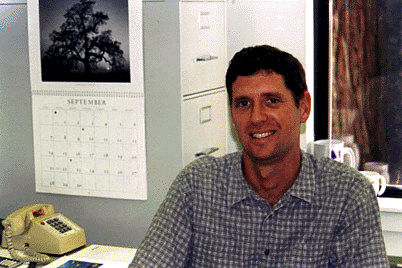![[Currents header graphic]](/homeart/currents_header.gif)
![[Currents header graphic]](/homeart/currents_header.gif)
January 12, 1998

|
|
Robert Fairlie
|
Not long ago, economist Robert Fairlie was curious about whether the influx of immigrants to California was prompting the parents of native-born schoolchildren to pull their children from public schools and enroll them in private schools.
Like any good social scientist, Fairlie did some preliminary research to explore the question and was intrigued by what he found. He applied to the Public Policy Institute of California (PPIC) for a grant to support an in-depth examination. The application was approved, and now, with $30,000 to support his efforts, Fairlie and colleague Julian Betts of the Economics Department at UC San Diego are busy doing a national survey of census data to look at trends in public and private school enrollment.
"Just from talking with friends and colleagues, it seemed to me like a lot of parents--especially those from wealthier, professional families--were taking their kids out of public schools and putting them in private school," said Fairlie.
The project is an important one for several reasons. First, research shows that students who attend private schools are more likely to complete high school and attend four-year colleges--two factors that have a large impact on future labor-market earnings. Second, if native-born students flee the public school system in large numbers, it could widen the inequality gap between immigrants and natives. And last, if high rates of immigration cause "flight" from public schools, it could erode political support for public education in California, with long-term consequences for students.
"There are a lot of important policy implications of this research, including whether we should consider a school-voucher program for poor kids to enable them to attend private schools," said Fairlie.
Only a few months into their 18-month project, Fairlie and Betts have uncovered some revealing preliminary data. Looking initially at enrollment figures for white, non-Hispanic, native-born Americans, Fairlie found that the percentage of high school students in California attending private schools increased from 8.1 percent in 1980 to 10.1 percent in 1990--a jump of almost 25 percent. During the same decade, Texas saw a similar jump of 26 percent, while New Jersey and New York each saw increases of 8 percent. Curiously, Florida and Illinois--two other states with high numbers of immigrants--each saw a drop in private high school enrollments. Nationwide, there was a 1 percent decrease.
"We will focus on the wealthiest native groups where we might expect the most 'flight' from the public school system," said Fairlie, who noted that nationwide the figure for all high school students attending private schools, including immigrants, declined by 1 percent.
California is an important state to look at because of the large numbers of immigrants who settle here. More than 300,000 immigrants came to California in 1992 alone--about one-third of all the immigrants who came to the United States that year, said Fairlie.
Fairlie and Betts are examining census data from 132 metropolitan areas, some of which have experienced large numbers of immigrants and others of which have been relatively untouched. They suspect that at least some of the parents are pulling their kids from public schools because they fear that the extra funding public schools receive for students with limited English proficiency (LEP) is not adequate and has caused the quality of their children's education to suffer.
"We will test to see if the cities with large increases in immigration also had large increases in the percentage of students going to private schools," said Fairlie. "We will also control for other factors--such as the pupil-teacher ratio, average teacher salaries, per-pupil spending, and demographic characteristics--to identify the actual effect of immigration on the school choices of native-born Americans."
Fairlie and Betts will coauthor a monograph on their findings that will be published by the PPIC at the end of 1998.